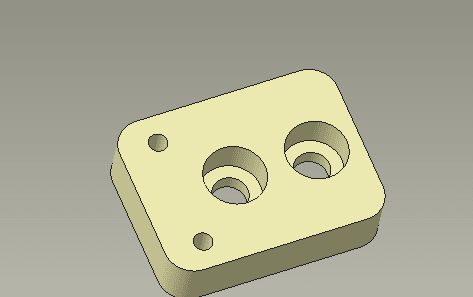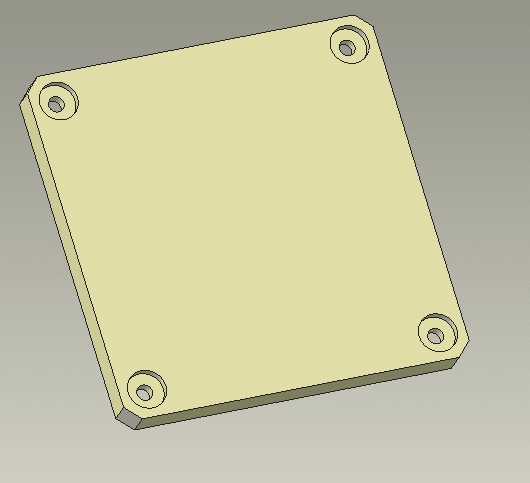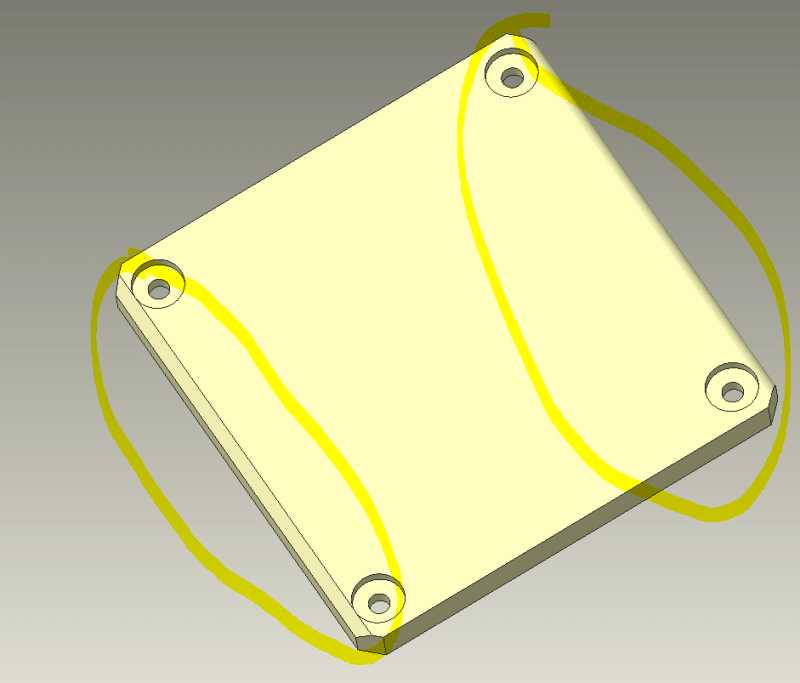Navigation
Install the app
How to install the app on iOS
Follow along with the video below to see how to install our site as a web app on your home screen.
Note: This feature may not be available in some browsers.
More options
Style variation
-
Congratulations cowski on being selected by the Eng-Tips community for having the most helpful posts in the forums last week. Way to Go!
You are using an out of date browser. It may not display this or other websites correctly.
You should upgrade or use an alternative browser.
You should upgrade or use an alternative browser.
Chamfer vs fillet cost 4
- Thread starter dejan95
- Start date
- Status
- Not open for further replies.
-
1
- #3
Welcome to the beginning of a long process of learning about machining. I've been doing this a very long time and I still call my favorite machinists on a regular basis and get their advice on how to design parts.
The first thing I want to say is this - Congratulations on starting your career with the right attitude - you still have a lot to learn! Too many young engineering graduates think they SHOULD know everything they need, so they don't ask questions. And they end up doing stupid stuff that gives us all a bad name.
So, in that vein, here's my answer - I don't know. Ask a machinist. The answer will probably depend on the equipment and tooling he has available. It will also depend on the level of precision that you ask for. That's another thing young engineers tend to do. Many of them think tight tolerances mean "good engineering", and they never think of the cost of their pointless drawing requirements.
My gut tells me that the machinist's answer might be the chamfer, because it's a straight cut, whereas the radius requires the tool to follow a curved path.
The first thing I want to say is this - Congratulations on starting your career with the right attitude - you still have a lot to learn! Too many young engineering graduates think they SHOULD know everything they need, so they don't ask questions. And they end up doing stupid stuff that gives us all a bad name.
So, in that vein, here's my answer - I don't know. Ask a machinist. The answer will probably depend on the equipment and tooling he has available. It will also depend on the level of precision that you ask for. That's another thing young engineers tend to do. Many of them think tight tolerances mean "good engineering", and they never think of the cost of their pointless drawing requirements.
My gut tells me that the machinist's answer might be the chamfer, because it's a straight cut, whereas the radius requires the tool to follow a curved path.
-
2
- #4
For CNC the rounded corner means not having a sharp change in direction, which means not having to slow down to go around the corner. The rounded corner does require a bit more material to be removed. In the old days the CNC controllers would have a glitch and leave a tiny mark at these changes but I think that's handled far better now.
However, if the part can be saw-cut to the outer dimension then the chamfer is an easy feature to add.
Chamfered edges, however, are almost always easier as there isn't a need guarantee tangency that a full radius does. That said, a softer corner can be made by running a round-over tool a little above and to the outside then being off a little is not as noticeable, avoids a gouge, and looks much better than a chamfer.
Consider also - if one goes to paint the part, the smoother the transitions, the less likely for the paint to pull in from surface tension and get thinner; in chamfers it's still easy to chip paint on those sharper 45 degree transitions; it may save money later to spend a little in making the part.
However, if the part can be saw-cut to the outer dimension then the chamfer is an easy feature to add.
Chamfered edges, however, are almost always easier as there isn't a need guarantee tangency that a full radius does. That said, a softer corner can be made by running a round-over tool a little above and to the outside then being off a little is not as noticeable, avoids a gouge, and looks much better than a chamfer.
Consider also - if one goes to paint the part, the smoother the transitions, the less likely for the paint to pull in from surface tension and get thinner; in chamfers it's still easy to chip paint on those sharper 45 degree transitions; it may save money later to spend a little in making the part.
Depends. Are these to be corner breaks or features? Corner breaks would be simple open dimension
chamfers which could be done by hand. Features would need size and location dimensions for machine operations. As noted, tangents of radiused edges may or may not be important.
Ted
chamfers which could be done by hand. Features would need size and location dimensions for machine operations. As noted, tangents of radiused edges may or may not be important.
Ted
-
1
- #6
Answer from an former machinist...JBooggs said:So, in that vein, here's my answer - I don't know. Ask a machinist.
Chamfers are underrated and under-loved.
Chamfers are easier to machine, as it just takes a single swipe of a cutter or quick dip with a countersink or maybe a bit of filing. External fillets require shaping.
If you want to blunt a sharp edge, a chamfer does a better job with less material removal.
I add tiny chamfers to keep edges of 3D prints from getting flash. Also helps with assembly.
For concave features like rib roots, fillets are better as they can be done with a ball-end mill. Also typically better for structure.
mfgenggear
Aerospace
dejan95
a better way to ask, is how it is made, and what would it take to machine it. what is the requirement?
a better way to ask, is how it is made, and what would it take to machine it. what is the requirement?
It depends on your design. A chamfer will leave edges, is it a part that will be handled, are there wires/cables near that edge?
Radii don't have the edges. On a CNC, either are just as easy to machine.
Chris, CSWP
SolidWorks
ctophers home
Radii don't have the edges. On a CNC, either are just as easy to machine.
Chris, CSWP
SolidWorks
ctophers home
The difference is so minor it isn't worth arguing over, tho' the discussion has been interesting.
I can see there may be times were one is preferred over the other, but the "sharp edge" concern is easily dealt with "break sharp edges", presumably no different to the post machining operation.
"Hoffen wir mal, dass alles gut geht !"
General Paulus, Nov 1942, outside Stalingrad after the launch of Operation Uranus.
I can see there may be times were one is preferred over the other, but the "sharp edge" concern is easily dealt with "break sharp edges", presumably no different to the post machining operation.
"Hoffen wir mal, dass alles gut geht !"
General Paulus, Nov 1942, outside Stalingrad after the launch of Operation Uranus.
Under most circumstances, on external edges, chamfers are cheaper to machine by an order of magnitude or more. The difference on internal corners is much smaller. Depending on what machines and tooling a particular machinist has available, they may charge you less for an internal fillet than they would for an internal chamfer in the exact same location. Best to ask them.
do you mean a part with radiused corners is 10x more than a part with chamfers ?
or that the small cost of the corner (compared to the overall cost) is higher ?
but that does surprise me ... in that such a difference would make chamfers much more cost effective.
"Hoffen wir mal, dass alles gut geht !"
General Paulus, Nov 1942, outside Stalingrad after the launch of Operation Uranus.
or that the small cost of the corner (compared to the overall cost) is higher ?
but that does surprise me ... in that such a difference would make chamfers much more cost effective.
"Hoffen wir mal, dass alles gut geht !"
General Paulus, Nov 1942, outside Stalingrad after the launch of Operation Uranus.
I know it's a different topic, but I'd spend much more time on designing with the cutter in minds, rather than making all the corner rads the same (which is easy to do in CAD, and doesn't require much thought).
"Hoffen wir mal, dass alles gut geht !"
General Paulus, Nov 1942, outside Stalingrad after the launch of Operation Uranus.
"Hoffen wir mal, dass alles gut geht !"
General Paulus, Nov 1942, outside Stalingrad after the launch of Operation Uranus.
mfgenggear
Aerospace
really matters what type of part, milling, turning, sheet metal, or specialties. on milling it's easier to chamfer on edges, on lathes can be either but it's harder to inspect radii, with lathes it has to be interpolated. both types can be hand buff after final machining. just make the tolerance liberal.
rb1957 said:or that the small cost of the corner (compared to the overall cost) is higher ?
I meant this.
On a typical CNC machine, a chamfer means 1 pass with either the same mill that's already been working, or possibly a single tool change to a countersink tool, and then a single pass on each edge with that tool. An external radius means a flat tool (ie, the end of an end mill) needs to be interpolated through the convex shape - this additional time is where the cost comes from.
This could have a very minor effect on the total part cost, or it could have a HUGE affect on total part cost, depending on a bunch of other factors.
For an internal corner, either a chamfer or radius means special tools and tool changes.. it's pretty much the same for either scenario, so not much cost difference.
If you're just trying to break sharp edges on a machined part, go with a small chamfer. It will be less expensive and to produce and inspect.
If the part is to be shot-peened, you probably want to have an edge break of .030" or bigger to avoid edge roll-over.
If it's a cast part, a radius will be your friend, as it will help the part release from its mould better.
A radius gives you slightly more cross sectional area than a fillet of the same size, so if you're very sensitive to stress, you might consider a fillet.
The function of the part really matters.
Your part looks like a machined blank-off plate. If so, a breakedge is probably just fine.
If the part is to be shot-peened, you probably want to have an edge break of .030" or bigger to avoid edge roll-over.
If it's a cast part, a radius will be your friend, as it will help the part release from its mould better.
A radius gives you slightly more cross sectional area than a fillet of the same size, so if you're very sensitive to stress, you might consider a fillet.
The function of the part really matters.
Your part looks like a machined blank-off plate. If so, a breakedge is probably just fine.
Chamfers vs. fillets on the first two pictures are pretty much the same cost.
Third picture (that has circled chamfers and fillets), 45° chamfers are the cheapest. You can just machine them by passing once in a straight line with a 45° milling chamfer tool. Also, you can make that chamfer by hand in a few seconds with a manual deburring tool. Radius requires multiple passes (and maybe also repositioning the workpiece in the machine), which increases the machining time significantly.
All said assumes part is plasma/laser/waterjet cut and/or machined (i.e. not cast, injection molded for example, I have no experience with those).
Third picture (that has circled chamfers and fillets), 45° chamfers are the cheapest. You can just machine them by passing once in a straight line with a 45° milling chamfer tool. Also, you can make that chamfer by hand in a few seconds with a manual deburring tool. Radius requires multiple passes (and maybe also repositioning the workpiece in the machine), which increases the machining time significantly.
All said assumes part is plasma/laser/waterjet cut and/or machined (i.e. not cast, injection molded for example, I have no experience with those).
mfgenggear
Aerospace
3DDAVE
interpolation on the lathe is faster and better than by hand, and more consistent. always plan to eliminate second operations as possible , when it is feasible. sure it can be hand deburr, but did you know deburring is the most expense and time consuming of a part.
interpolation on the lathe is faster and better than by hand, and more consistent. always plan to eliminate second operations as possible , when it is feasible. sure it can be hand deburr, but did you know deburring is the most expense and time consuming of a part.
3DDave said:Just use a round-over bit, same as a chamfer tool. No need to interpolate.
Roundover bits certainly exist - but most CNC machines are not going to be equipped with the exact tool required to make whatever external radius you've specified on a part, and machine shops are not going to buy single-use tools for a small run of parts.
mfgenggear
Aerospace
swinnyGG
on milled parts as the OP shows, I like chamfers, 45 deg. that way to remove burrs hand buff the edges or tumble deburr, there will be burrs no matter
on milled parts as the OP shows, I like chamfers, 45 deg. that way to remove burrs hand buff the edges or tumble deburr, there will be burrs no matter
- Status
- Not open for further replies.
Similar threads
- Locked
- Question
- Replies
- 3
- Views
- 2K
- Replies
- 23
- Views
- 6K
- Locked
- Question
- Replies
- 16
- Views
- 4K
- Locked
- Question
- Replies
- 9
- Views
- 2K
- Locked
- Question
- Replies
- 14
- Views
- 965



